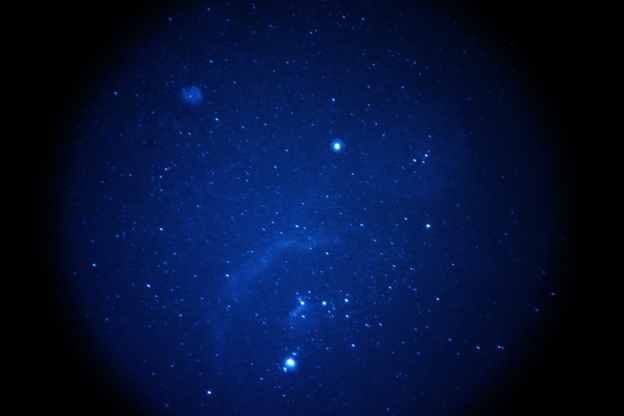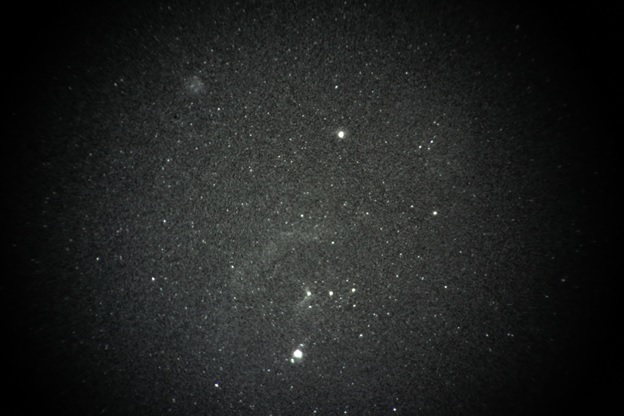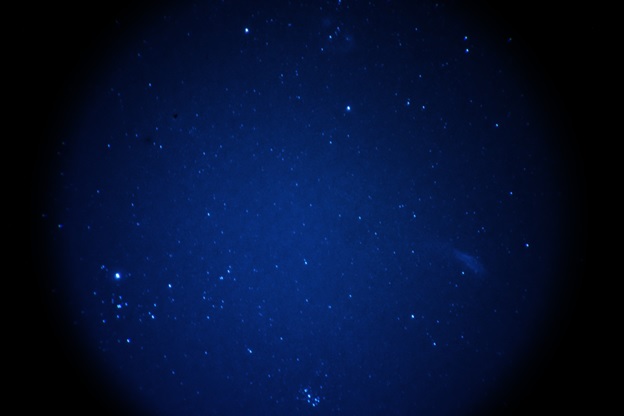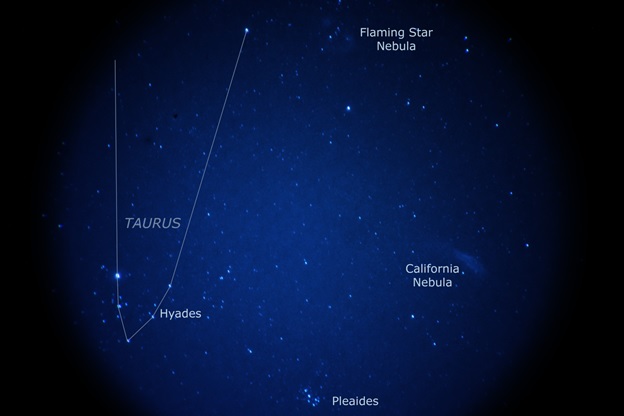
Stargazing and Imaging with Night Vision Gear
Increasingly, amateur astronomers have been using terrestrial night vision gear to observe the night sky. When properly equipped, terrestrial night vision scopes can allow observers to see objects in real time that are far too faint to see with the naked eye or binoculars, but much too large to fit into the field of view of most telescopes that can be set up for long exposure astrophotography.
We recently acquired an “NVD Micro” night vision monocular that is set up to allow us to view the night sky at “unity,” which means at one power (1x) magnification. In other words, the monocular allows us to view an unmagnified image that’s at exactly the same scale as what we see with the naked eye.
Here’s what our observatory looks like through the NVD Micro monocular at 1x from about 100 yards away, photographed with our modded Canon 6D DSLR camera using a 50mm Canon EF f/1.8 STM lens attached directly to the camera, with the NVD Micro night vision monocular mounted in front of the 50mm lens, with an ENVIS objective lens mounted in front of the monocular, and with a 12nm Astronomik Hydrogen-Alpha filter mounted on the very front of the whole setup:

Many night vision scopes are green, but ours uses a P45 white phosphor Generation III image intensifier manufactured by L-3 to yield the bluish-white image seen above. The image above is a 30 second exposure. In real-time, the image is less blue and a bit grainier, as shown below:

Now for the really fun part – images of the sky!
Check out this 30 second unguided photo of the constellation Orion using the same setup as described above, showing the Rosette Nebula in the upper left off Orion’s left shoulder, the Great Nebula in Orion, the nebulosity near the belt star Alnitak that includes the Horsehead Nebula, elusive Barnard’s Loop (first time I’d ever seen it), and the Angelfish Nebula around Orion’s head, which is also called the Meissa Ring! ALL IN ONE FRAME!!! WOW!!!

Same image as above, with constellation lines and labels added:

A real-time view of this same field without the camera or 30 second exposure time would look less blue and a bit grainier. More like this:

Now check out this 30 second unguided photo that includes the Hyades region (i.e., the “face” of Taurus the bull), the Pleaides star cluster, the California Nebula in Perseus, and the Flaming Star Nebula in Auriga (first time I’d ever seen either of those last two), all in one frame!

Same image as above, with constellation lines and labels added:

Finally, here’s a 30 second unguided photo of the constellation Canis Major (the “Great Dog”), including the bright star Sirius, with the Seagull Nebula visible off to the left. (Yep, first time I’d ever seen the Seagull Nebula, too.)

Same image as above, with constellation lines and labels added:

We saw these things in real time with the lightweight handheld monocular and photographed them all in one night, in under an hour, on our first night out with this new gear! It’s that easy to use.
We are absolutely blown away by what we’re seeing with this incredible new piece of equipment that’s showing us things that are so dim and spread out that most amateur astronomers have never seen or photographed them, much less in the same frame together. I cannot wait to see the Sagittarius Arm of the Milky Way with this monocular, or to try to mount our Canon fisheye lens on it and try for wide-angle Milky Way photos without having to journey to a dark sky site.
Go to Page 2 of Stargazing and Imaging with Night Vision Gear
Go to Main Page on Photos of Deep-Sky Objects
Copyright 2025 StarlingSkyBlog